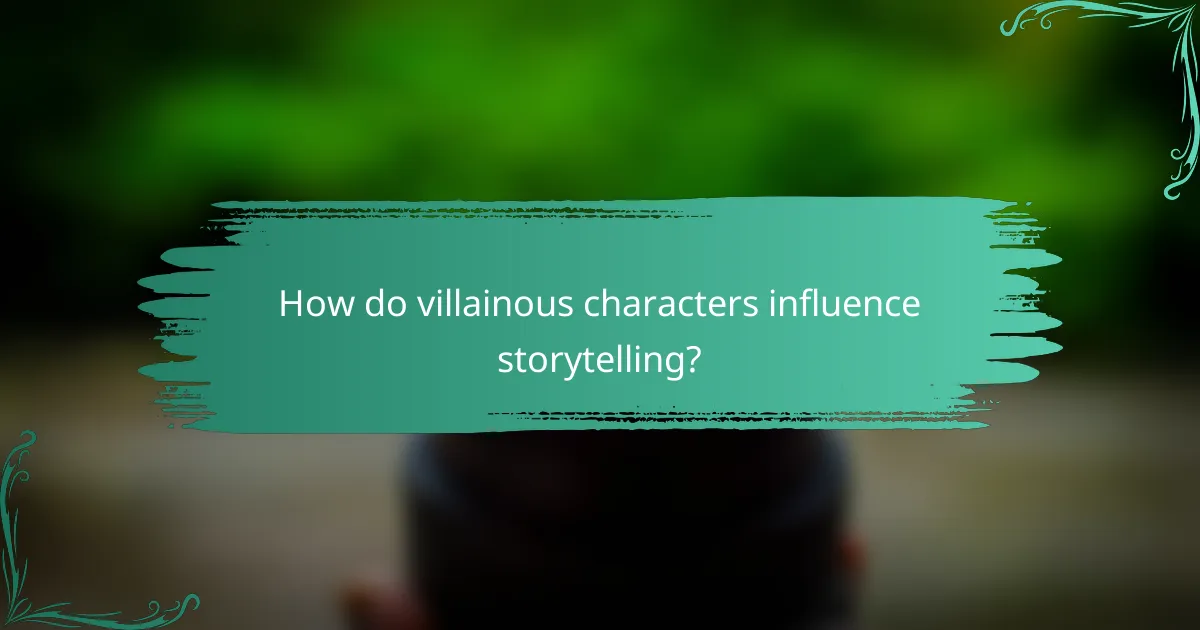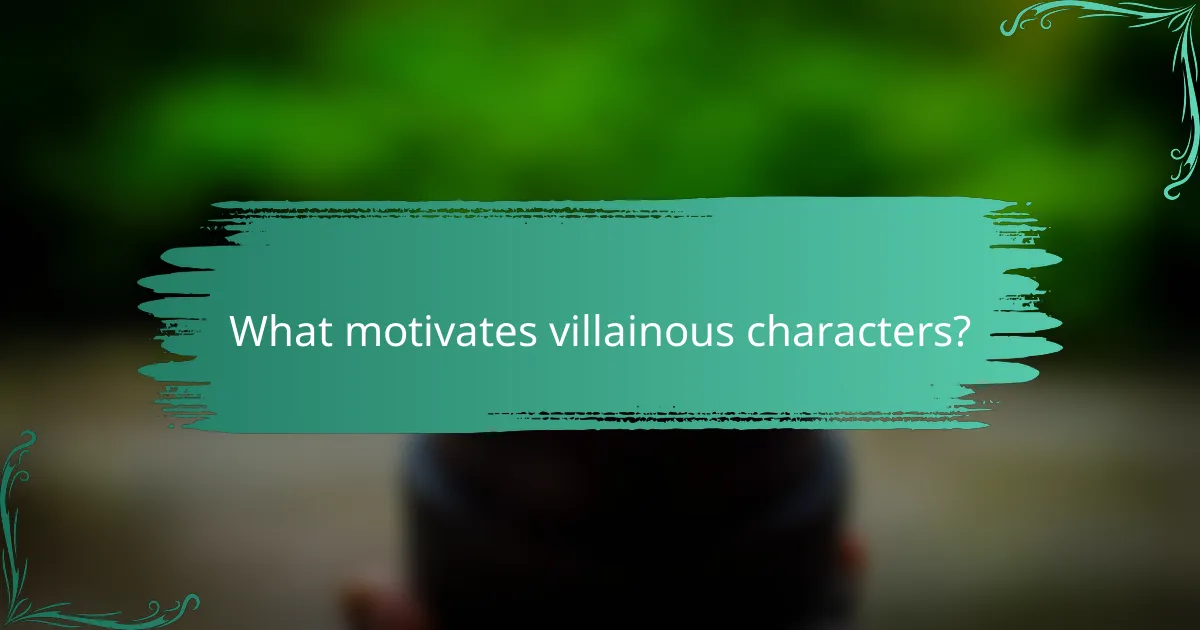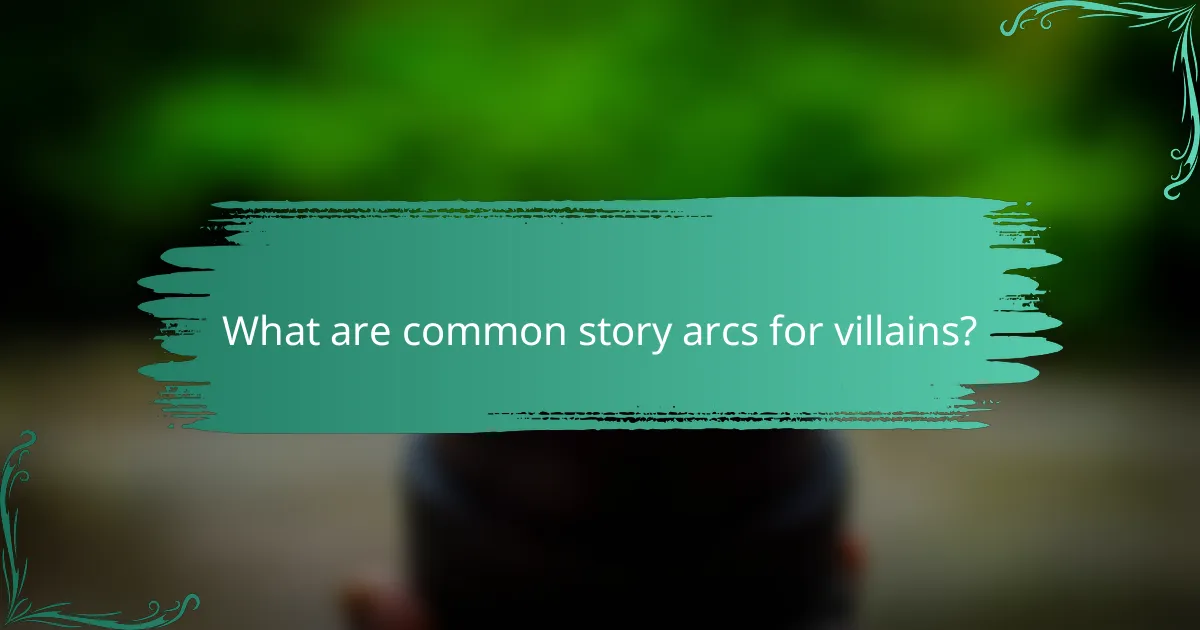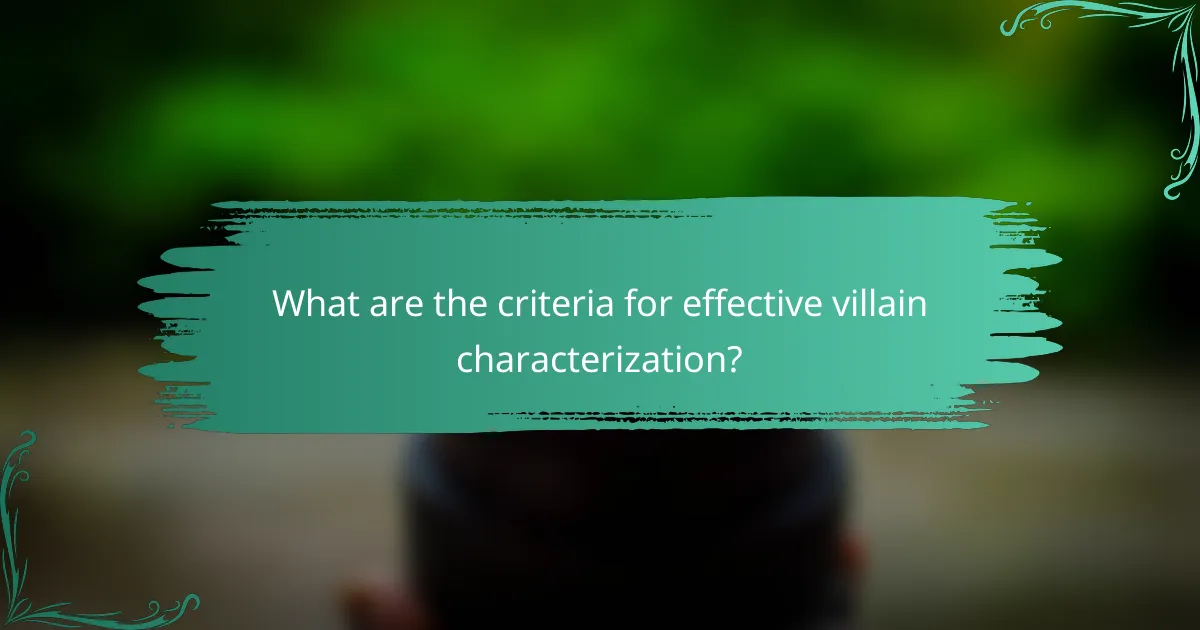Villainous characters are integral to storytelling, as they create conflict and enrich the emotional depth of the narrative. Their complex motivations not only illuminate their personalities but also propel the story forward, often leading to transformative arcs that explore themes of redemption, downfall, and change. Understanding these dynamics enhances our appreciation of the intricate relationships between heroes and villains within the plot.

How do villainous characters influence storytelling?
Villainous characters play a crucial role in storytelling by driving conflict and shaping the narrative’s emotional landscape. Their motivations and actions often serve as catalysts for character growth and thematic exploration, making them essential to the overall plot structure.
Character development
Villains often serve as foils to the protagonists, highlighting their strengths and weaknesses. This contrast can lead to significant character development, as heroes are forced to confront their fears and evolve in response to the challenges posed by their adversaries.
For instance, a hero’s journey may involve overcoming personal doubts that a villain embodies, creating a dynamic interplay that enriches both characters. This development can resonate with audiences, making the narrative more relatable and engaging.
Plot progression
Villainous characters are central to plot progression, as their actions typically create obstacles that the protagonist must navigate. These conflicts can escalate tension and maintain audience interest, driving the story forward.
For example, a villain’s scheme might lead to a series of events that force the hero to make difficult choices, ultimately shaping the story’s trajectory. This progression keeps the narrative compelling and ensures that the stakes remain high throughout.
Themes and moral lessons
The presence of a villain often allows for the exploration of complex themes such as morality, power, and redemption. Through their actions and motivations, villains can challenge the protagonist’s beliefs, prompting deeper reflections on right and wrong.
For instance, a story might examine the consequences of revenge through a villain’s quest for vengeance, ultimately leading to a moral lesson about forgiveness and understanding. This thematic depth adds layers to the narrative, making it more thought-provoking for the audience.

What motivates villainous characters?
Villainous characters are often driven by deep-seated motivations that shape their actions and decisions. Understanding these motivations can provide insight into their complex personalities and the narratives they inhabit.
Personal trauma
Many villains are shaped by personal trauma, which can stem from childhood experiences, loss, or betrayal. This trauma often manifests as a desire to exert control or inflict pain on others, reflecting their own unresolved issues.
For example, a character who experienced abandonment may become a villain to ensure no one else feels that pain, often leading to destructive behaviors. Recognizing this can add depth to their story arc and make them more relatable.
Desire for power
A strong desire for power is a common motivation among villains, driving them to seek control over others or their environment. This quest for dominance can stem from feelings of inadequacy or a belief that power will bring them respect and security.
Villains motivated by power often employ manipulation, coercion, or violence to achieve their goals. Their actions can serve as a cautionary tale about the corrupting influence of unchecked ambition.
Revenge
Revenge is a powerful motivator for many villainous characters, often rooted in perceived injustices or betrayals. This desire for retribution can lead them down a dark path, where they justify their actions as a means to restore balance or achieve closure.
For instance, a character wronged by a former ally may seek vengeance, believing that their actions are justified. This motivation can create compelling conflicts and drive the narrative forward, highlighting the destructive nature of revenge.

What are common story arcs for villains?
Common story arcs for villains include their journeys through redemption, downfall, and transformation. Each arc explores different motivations and consequences, shaping the villain’s role within the narrative and influencing the overall story dynamics.
Redemption arcs
Redemption arcs focus on a villain’s journey towards atonement and moral recovery. These characters often start with a dark past but seek to change their ways, motivated by guilt, love, or a desire for forgiveness. A classic example is the character of Severus Snape in the “Harry Potter” series, who ultimately seeks redemption for his past actions.
When crafting a redemption arc, consider the villain’s motivations and the stakes involved. Ensure that their journey feels authentic and relatable, allowing the audience to empathize with their struggles. Avoid making the redemption too easy; it should involve significant challenges and sacrifices.
Downfall arcs
Downfall arcs depict the gradual decline of a villain, often leading to their ultimate defeat or demise. These characters may be driven by ambition, hubris, or a desire for power, which ultimately leads to their undoing. A well-known example is Walter White from “Breaking Bad,” whose quest for control results in tragic consequences.
To effectively write a downfall arc, highlight the villain’s flaws and the choices that lead to their downfall. Create tension by showing how their actions impact others and the world around them. The downfall should feel inevitable, yet surprising, maintaining audience engagement until the end.
Transformation arcs
Transformation arcs involve a villain undergoing significant change, often shifting from antagonist to ally or vice versa. This arc explores the complexities of their character, revealing deeper motivations and potential for growth. An example is the character of Loki from the Marvel Cinematic Universe, who evolves from a villain to a more nuanced character with redeeming qualities.
When developing a transformation arc, focus on the internal and external factors that drive change. Consider how relationships, experiences, and conflicts shape the character’s evolution. Ensure that the transformation is gradual and believable, allowing the audience to witness the character’s journey authentically.

How do villains shape audience perceptions?
Villains play a crucial role in shaping audience perceptions by embodying conflict and moral ambiguity. Their actions and motivations often prompt viewers to reflect on their own values and beliefs, creating a deeper engagement with the story.
Empathy for villains
Empathy for villains can enhance the emotional depth of a narrative. When audiences understand a villain’s backstory or motivations, they may begin to see them as complex characters rather than mere antagonists. For example, a villain driven by a tragic past can evoke sympathy, making their actions more relatable.
Writers can foster this empathy by revealing the villain’s vulnerabilities or by placing them in situations that resonate with the audience’s own experiences. This approach can blur the lines between good and evil, encouraging viewers to question their own judgments.
Fear and tension creation
Villains are essential for creating fear and tension in a story. Their unpredictable nature and threatening actions can keep audiences on the edge of their seats. Effective villains often possess traits that amplify this tension, such as intelligence, ruthlessness, or supernatural abilities.
To maximize fear, writers should develop villains whose goals directly oppose those of the protagonists. This conflict can lead to suspenseful scenarios, where the audience is left wondering how the heroes will overcome the looming threat.
Reflection of societal issues
Villains often serve as a reflection of societal issues, embodying fears, prejudices, or moral dilemmas prevalent in a given culture. For instance, a villain who exploits economic disparities can highlight themes of inequality and injustice, prompting audiences to consider real-world implications.
By aligning a villain’s motivations with contemporary issues, writers can create a more resonant narrative. This connection encourages viewers to engage critically with both the story and the societal context, fostering a deeper understanding of the underlying themes.

What are the criteria for effective villain characterization?
Effective villain characterization hinges on their complexity, relatability, and consistency. These elements create a multi-dimensional antagonist that enhances the narrative and engages the audience.
Complex motivations
Villains with complex motivations are often driven by a mix of personal desires, past traumas, and societal influences. For instance, a character might seek revenge due to a childhood betrayal, blending personal history with broader themes of justice or power. This depth makes their actions more understandable and compelling.
When crafting a villain, consider incorporating conflicting motivations that can evolve throughout the story. This can lead to unexpected twists and a richer narrative, as audiences grapple with the villain’s choices and their implications.
Relatable traits
Relatable traits in villains allow audiences to connect with them on a human level. For example, a villain may exhibit traits like insecurity, ambition, or a desire for acceptance, which can mirror the struggles of everyday people. This connection can evoke empathy, making the villain’s journey more engaging.
To enhance relatability, avoid creating one-dimensional characters. Instead, give them flaws and vulnerabilities that resonate with the audience, ensuring that their actions, while villainous, stem from understandable human emotions.
Consistent behavior
Consistent behavior in villains is crucial for maintaining believability. Their actions should align with their established motivations and traits throughout the story. For example, a villain who values loyalty should not betray their closest ally without a compelling reason that fits their character arc.
To ensure consistency, outline key traits and motivations before writing. Regularly revisit these elements during the writing process to avoid contradictions that could confuse the audience or undermine the character’s impact.

How do cultural contexts affect villain portrayals?
Cultural contexts significantly shape how villains are portrayed in stories, influencing their characteristics, motivations, and arcs. Different regions and historical backgrounds contribute to unique interpretations of villainy, impacting audience perceptions and expectations.
Regional stereotypes
Regional stereotypes play a crucial role in villain portrayals, often reflecting societal fears or biases. For instance, a villain from Eastern Europe may be depicted with a cold, calculating demeanor, while a character from the American South might embody traits of charm mixed with menace. These stereotypes can reinforce or challenge cultural narratives, affecting how audiences relate to the villain.
Writers should be cautious of relying too heavily on stereotypes, as this can lead to one-dimensional characters. Instead, incorporating nuanced traits that reflect the complexity of real individuals can create more engaging and relatable villains.
Historical influences
Historical influences shape villain portrayals by embedding societal conflicts and fears into character motivations. For example, during the Cold War, villains often represented ideological threats, such as communism, while contemporary narratives might focus on issues like corporate greed or environmental destruction. Understanding the historical context can help writers craft villains that resonate with current societal concerns.
When developing a villain, consider the historical events that may inform their actions or beliefs. This can add depth and realism, making the character’s motivations more compelling and relevant to the audience.
Media representation
Media representation significantly impacts how villains are perceived across cultures. Films, television shows, and literature often depict villains in ways that reflect or challenge societal norms. For example, the portrayal of female villains has evolved, with characters like Maleficent and Cersei Lannister showcasing complex motivations beyond traditional evil archetypes.
Writers should analyze current media trends to understand how villains are represented and received. Engaging with diverse perspectives can lead to richer character development and a more profound impact on the audience, moving beyond clichés to create memorable and thought-provoking antagonists.
